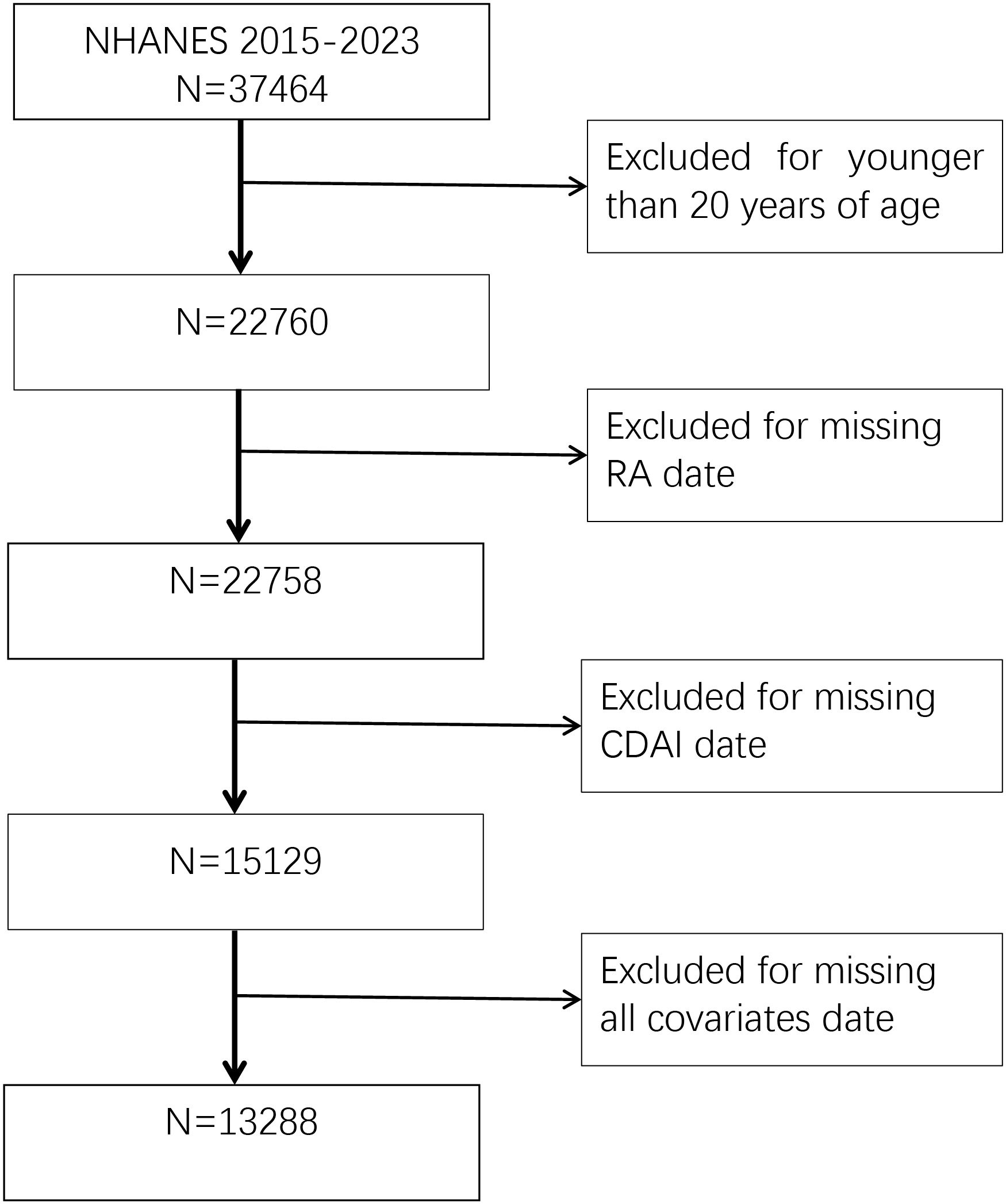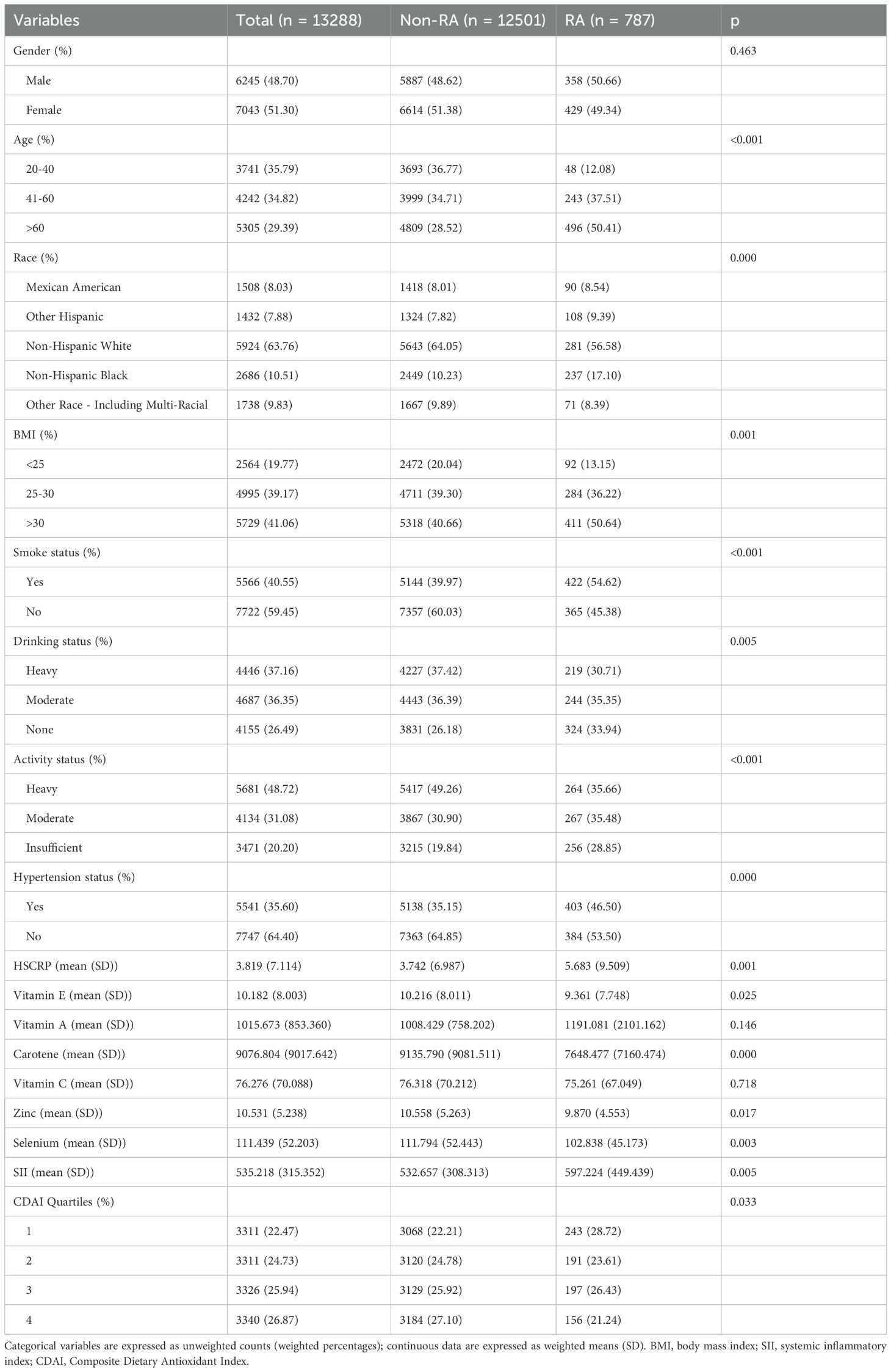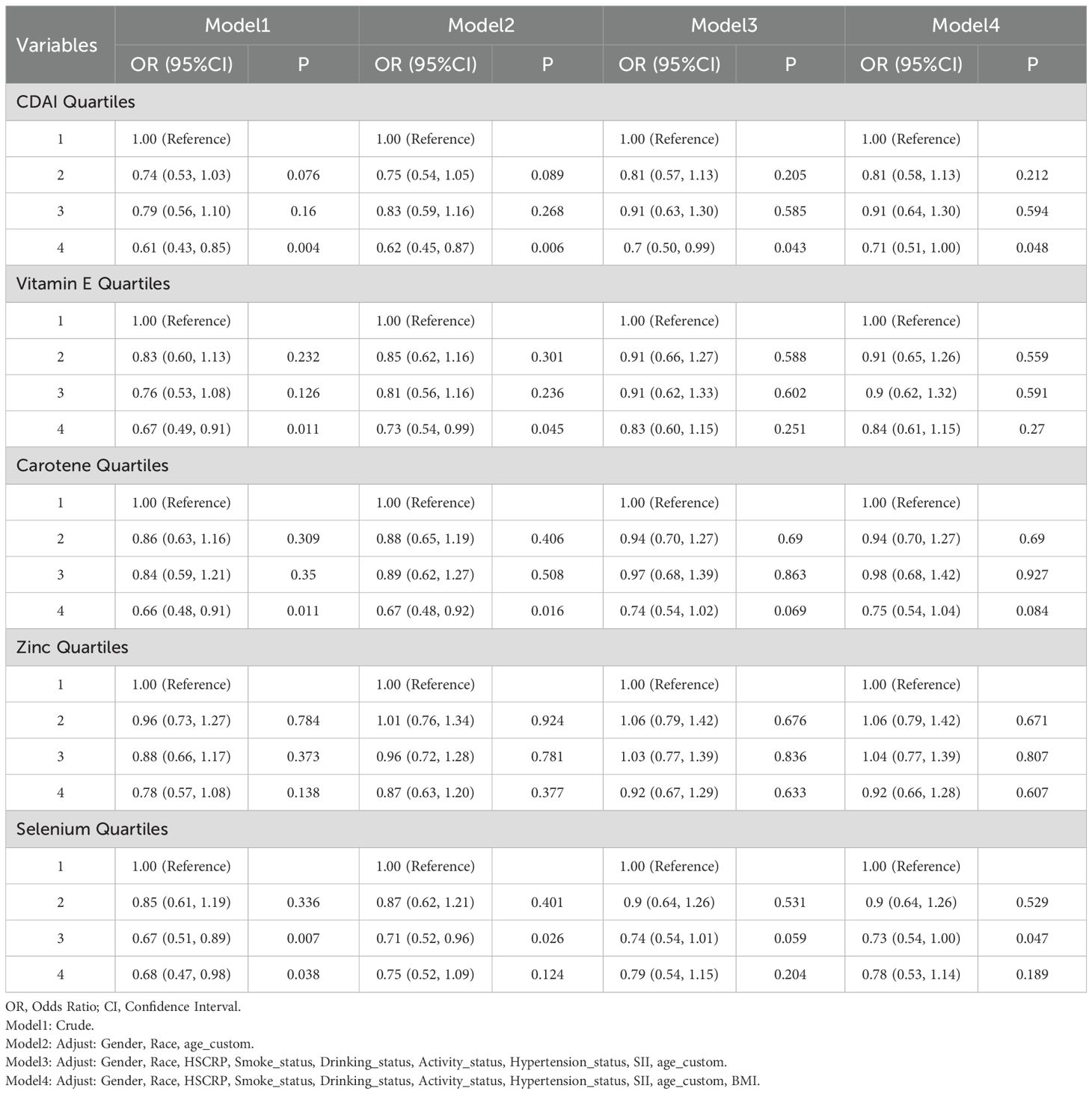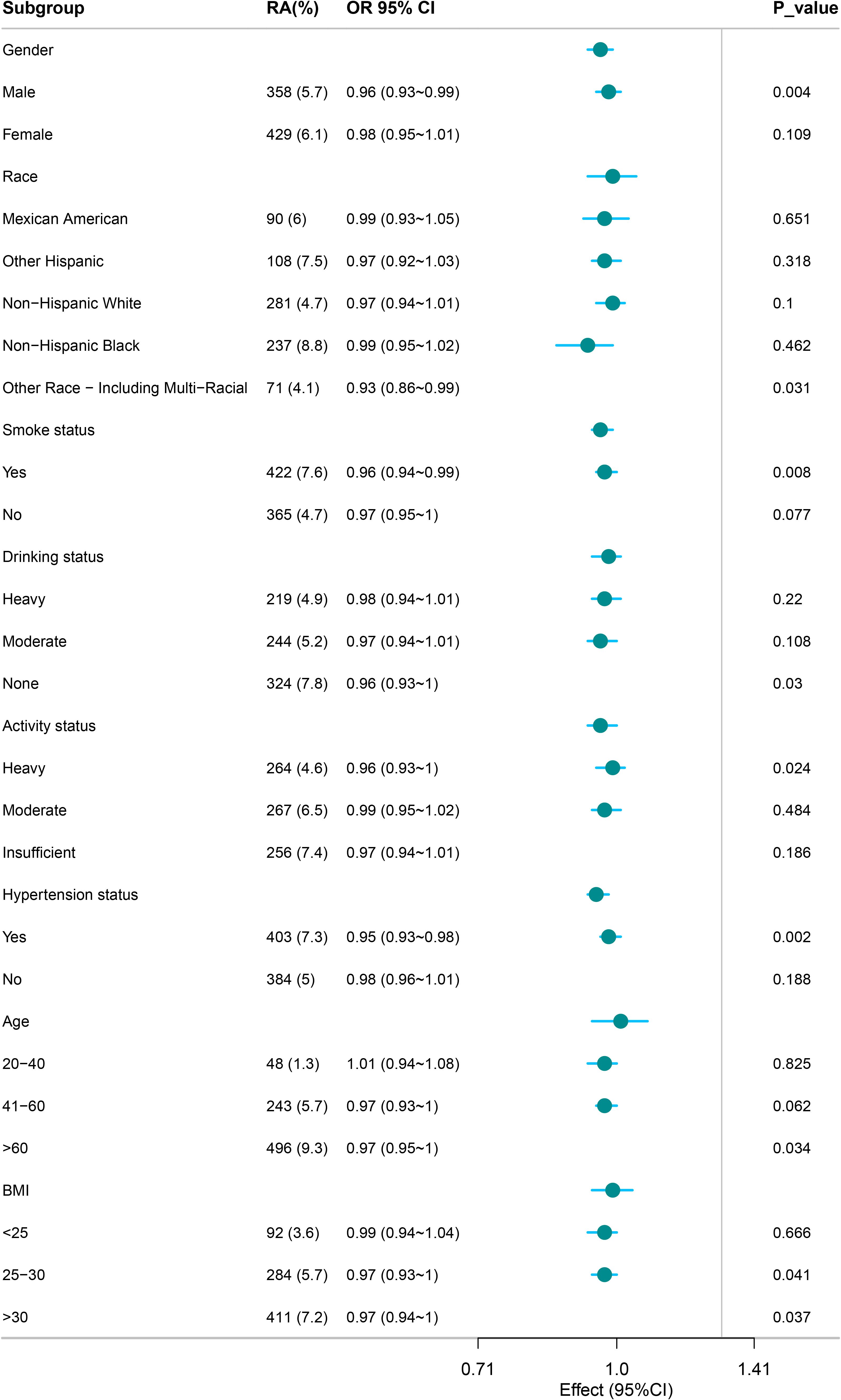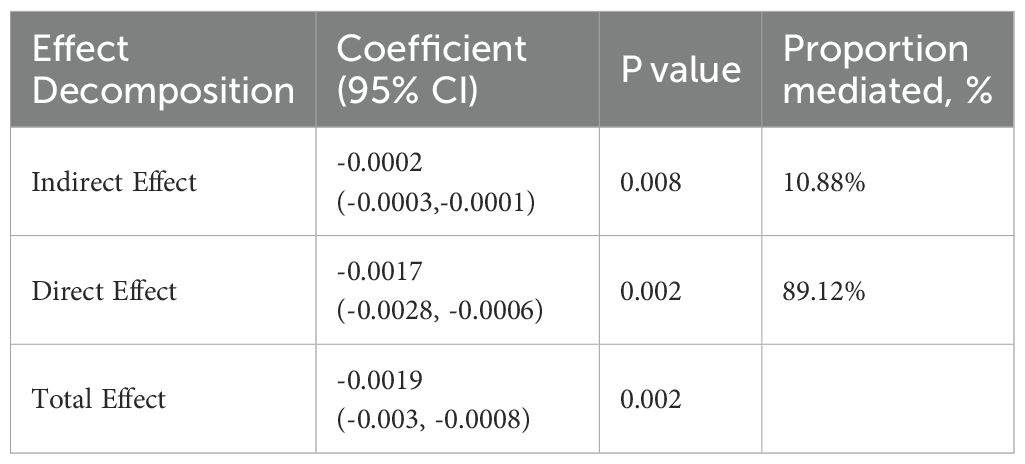- 1Orthopaedics of Zigong Fourth People’s Hospital, Zigong, Sichuan, China
- 2Respiratory Medicine of Zigong Fourth People’s Hospital, Zigong, Sichuan, China
Background: The Clinical Dietary Antioxidant Index (CDAI) is a dietary antioxidant assessment index. Although CDAI has been shown to play a role in various chronic diseases, its association with rheumatoid arthritis (RA) remains underexplored. The aim of this study was to investigate the relationship between the CDAI and RA in U.S. adults, and to examine the mediating role of body mass index (BMI) in the relationship between CDAI and RA incidence.
Methods: This cross-sectional study utilized data from the 2015–2023 National Health and Nutrition Examination Survey (NHANES). Weighted multivariate logistic regression models, restricted cubic spline (RCS) functions, and subgroup analyses were employed to examine the association between CDAI levels and RA in American adults. Mediation analysis was conducted to explore the mediating role of BMI in the relationship between CDAI and RA incidence.
Results: A total of 13,288 participants were included, of whom 787 were diagnosed with RA, with a prevalence rate of 5.9%. Weighted multivariate logistic regression analyses across all four models showed a negative correlation between CDAI levels in the highest quartile and RA incidence. Restricted cubic spline curves revealed a non-linear negative association between CDAI, vitamin E, carotenoids, selenium, and RA incidence. As levels of CDAI, vitamin E, carotenoids, and selenium increased, the risk of RA decreased. Subgroup analyses and forest plots indicated significant associations between CDAI levels and RA across subgroups, including females, individuals aged over 60 years, Other Race - Including Multi-Racial groups, smokers, non-drinkers, individuals with heavy physical activity, hypertension, and BMI >25 (P < 0.05). Mediation analysis showed that BMI partially mediated the relationship between CDAI and RA, accounting for 10.88% of the effect.
Conclusions: CDAI levels were negatively associated with RA incidence, particularly the components of CDAI such as vitamin E, carotenoids, and selenium. BMI mediated the relationship between CDAI and RA.
1 Introduction
Rheumatoid arthritis (RA) is a common chronic autoimmune disease primarily characterized by inflammation, swelling, and pain in multiple joints, which can lead to joint destruction and functional impairment over time (1). A systematic review revealed that RA incidence varies across countries, with the highest reported in Cuba (2.7%) and the lowest in the Philippines (0.17%) (2). Additionally, a Global Burden of Disease study indicated that the global burden of RA has been increasing steadily over the past 30 years, with the number of RA patients projected to rise from approximately 1.07 million at the end of 2019 to about 1.5 million by 2040 (3). Given the rising global burden of RA, identifying effective preventive strategies is crucial for public health. The increasing prevalence of RA underscores the need for early intervention and lifestyle modifications to reduce disease risk.
RA patients often experience significant chronic inflammation and oxidative stress, which not only exacerbate disease progression but also substantially reduce their quality of life (4, 5). Although current treatment options focus on immunosuppressive and anti-inflammatory drugs (6, 7), they have not fully addressed the underlying mechanisms of RA onset and progression. In recent years, dietary interventions have gained widespread attention as a potential strategy for the prevention and management of RA. Hulander et al. (8) demonstrated that an anti-inflammatory diet—characterized by high intake of fatty fish, whole grains, fruits, nuts, and berries—can reduce systemic inflammation and lower ESR levels in RA patients. Another study by Hulander et al. (9) showed that an anti-inflammatory diet improves lipid profiles in RA patients, offering cardiovascular protection.
The Composite Dietary Antioxidant Index (CDAI) is a comprehensive metric used to evaluate dietary antioxidant levels. It integrates the intake of multiple antioxidants, including vitamins A, C, and E, carotenoids, zinc, and selenium, and reflects the overall capacity of dietary patterns to counteract inflammation and oxidative stress. Previous studies have shown that CDAI is negatively associated with the risk of several chronic diseases, such as diabetes, hypertension, and fatty liver (10–12). CDAI is a comprehensive measure of dietary antioxidants, such as vitamin E, carotenoids, and selenium, which have been shown to play a significant role in inflammation and oxidative stress (13–16)—key factors in the pathogenesis of RA. While the Dietary Inflammatory Index and the Healthy Eating Index are also relevant, CDAI offers a more comprehensive antioxidant index that specifically relates to reducing oxidative stress, a hallmark of RA. However, the potential association between CDAI and RA risk has not been extensively validated, especially in large, population-based studies.
This study aims to explore the association between CDAI and RA risk in American adults using data from the 2015–2023 National Health and Nutrition Examination Survey (NHANES) and further evaluate the mediating role of body mass index (BMI) in this relationship. We hypothesize that higher dietary antioxidant intake (reflected by higher CDAI) is associated with a reduced risk of RA and that BMI partially mediates this relationship. In addition, we consider BMI as a mediator rather than a confounder. BMI plays a key role in modulating inflammation, as adipose tissue releases pro-inflammatory cytokines (e.g., IL-6, TNF-α) (17), which increase the inflammatory burden. Given that oxidative stress and inflammation are critical mechanisms in the pathogenesis of RA, we hypothesize that BMI may act as a mediator in the relationship between CDAI and RA risk.
2 Participants and methods
2.1 Study population
This study is a cross-sectional analysis utilizing data from the 2015–2023 National Health and Nutrition Examination Survey (NHANES), a nationally representative health and nutrition survey targeting non-institutionalized adults in the United States. The detailed survey methodology and data collection processes for NHANES have been approved by the National Center for Health Statistics (NCHS) Review Board and are publicly available on its official website. All participants provided informed consent.
This study includes data from 37,464 individuals who participated in the NHANES survey between 2015 and 2023. We excluded participants under the age of 20, as well as those with missing data on rheumatoid arthritis (RA), CDAI, BMI, HSCRP, SII, physical activity, hypertension, smoking, alcohol consumption, and other covariates. After exclusions, a total of 13,288 participants were included in the analysis (Figure 1).
2.2 Exposure variables: CDAI assessment
The Composite Dietary Antioxidant Index (CDAI) was calculated using 24-hour dietary recall data from the NHANES database. We referenced the modified CDAI calculation method proposed by Wright et al. (18), which involves the intake of six dietary antioxidants (vitamins A, C, E, carotenoids, zinc, and selenium). Specifically, the intake of each antioxidant was standardized (i.e., by subtracting the mean and dividing by the standard deviation), and then the standardized intake values of the antioxidants were summed to obtain the CDAI score. Higher CDAI scores indicate higher intake of dietary antioxidants.
2.3 Outcome variables: RA assessment
The diagnosis of RA was based on the medical conditions questionnaire in NHANES, with the question: “Has a doctor or other health professional ever told you that you have arthritis?” If the answer was “Yes,” participants proceeded to the next question: “What type of arthritis?” Participants who answered “Rheumatoid Arthritis” were classified into the RA group, while the rest were categorized as non-RA.
2.4 Covariates determination
We considered potential covariates that could influence the relationship between CDAI and RA, including gender, age, race, BMI, smoking status, alcohol consumption, hypertension, physical activity, serum HSCRP levels, and SII. Data for gender, age, race, smoking, alcohol consumption, and physical activity were collected via questionnaires. Race was categorized into the following groups: Mexican American, Other Hispanic, Non-Hispanic White, Non-Hispanic Black, and Other Race - Including Multi-Racial. Smoking status was classified based on questionnaire responses into “Yes” or “No.” Alcohol consumption was categorized based on the question: “During the past 12 months, on those days that you drank alcoholic beverages, on the average, how many drinks did you have?” The results were classified as heavy (men: ≥3 drinks/day or women: ≥2 drinks/day), moderate (men: 1–2 drinks/day or women: 1 drink/day), or none (19). Hypertension was defined based on the average of three measurements of systolic and diastolic blood pressure, with hypertension defined as systolic blood pressure ≥130 mmHg or diastolic blood pressure ≥80 mmHg (20). Physical activity was categorized as Heavy, Moderate, or Insufficient based on responses to questions about vigorous recreational or work activities. Participants who reported vigorous activity in either category were classified as “Heavy,” moderate activity in either category was classified as “Moderate,” and the remaining participants were classified as “Insufficient.” BMI was assessed based on physical examination results and categorized into three groups: <25, 25–30, and >30. Serum HSCRP levels were measured using laboratory test results. SII was calculated from blood analysis using neutrophil, lymphocyte, and platelet counts, as follows: SII = (platelet count × neutrophil count)/lymphocyte count.
2.5 Statistical analysis
The NHANES data were weighted using the survey weights provided by the National Center for Health Statistics (NCHS) to ensure the sample is representative of the U.S. adult population. Continuous variables that followed a normal distribution were expressed as weighted means ± standard deviation (SD), while categorical variables were expressed as weighted percentages. Differences were analyzed using weighted Student’s t-test and weighted χ² test.
To evaluate the relationship between CDAI and RA, weighted multivariate logistic regression models were used. Four models were constructed to adjust for covariates:
Model 1: No covariate adjustment.
Model 2: Adjusted for gender, age, and race.
Model 3: Adjusted for gender, age, race, smoking, alcohol consumption, hypertension, physical activity, HSCRP, and SII.
Model 4: Adjusted for all variables in Model 3 + BMI.
We used restricted cubic splines (RCS) to assess the non-linear relationship between CDAI and RA. Subgroup analyses and forest plots were used to further evaluate the relationship between CDAI and RA in various subgroups, The subgroups were selected based on known risk factors for RA, including age, gender, BMI, and smoking status. Mediation analysis was performed to assess the mediating role of BMI in the relationship between CDAI and RA, and the mediation effect proportion was calculated.
Statistical analyses were conducted using R software (version 4.2.0). A P-value <0.05 was considered statistically significant.
3 Results
3.1 Participant characteristics
A total of 13,288 participants were included in this study, of whom 787 were diagnosed with rheumatoid arthritis (RA) (5.9%) and 12,501 were non-RA participants (94.1%). Statistically significant differences (P < 0.05) were observed between the two groups in terms of age, race, BMI, smoking status, drinking status, activity status, hypertension status, HSCRP, vitamin E, carotene, zinc, selenium, SII, and CDAI (Table 1).
3.2 CDAI and RA correlation analysis
Weighted multivariate logistic regression analyses across all four models showed a negative correlation between CDAI levels in the highest quartile and RA incidence. Using the lowest quartile as the reference, the unadjusted model revealed an odds ratio (OR) of 0.61 (95% CI: 0.43–0.85, P = 0.004) for the highest CDAI quartile. The model adjusted for gender, race, and age showed an OR of 0.62 (95% CI: 0.45–0.87, P = 0.006). The model adjusted for all variables except BMI showed an OR of 0.70 (95% CI: 0.50–0.99, P = 0.043), and the fully adjusted model, including BMI, showed an OR of 0.71 (95% CI: 0.51–1.00, P = 0.048). Furthermore, in the unadjusted model and the model adjusted for gender, race, and age, vitamin E and carotene, as well as selenium in the unadjusted model, also demonstrated a negative correlation with RA incidence in the highest quartile (P < 0.05) (Table 2).
Restricted cubic spline (RCS) analysis showed a non-linear negative correlation between CDAI, vitamin E, carotene, selenium, and RA incidence. As CDAI, vitamin E, carotene, and selenium levels increased, the risk of RA decreased (P < 0.05) (Figure 2).
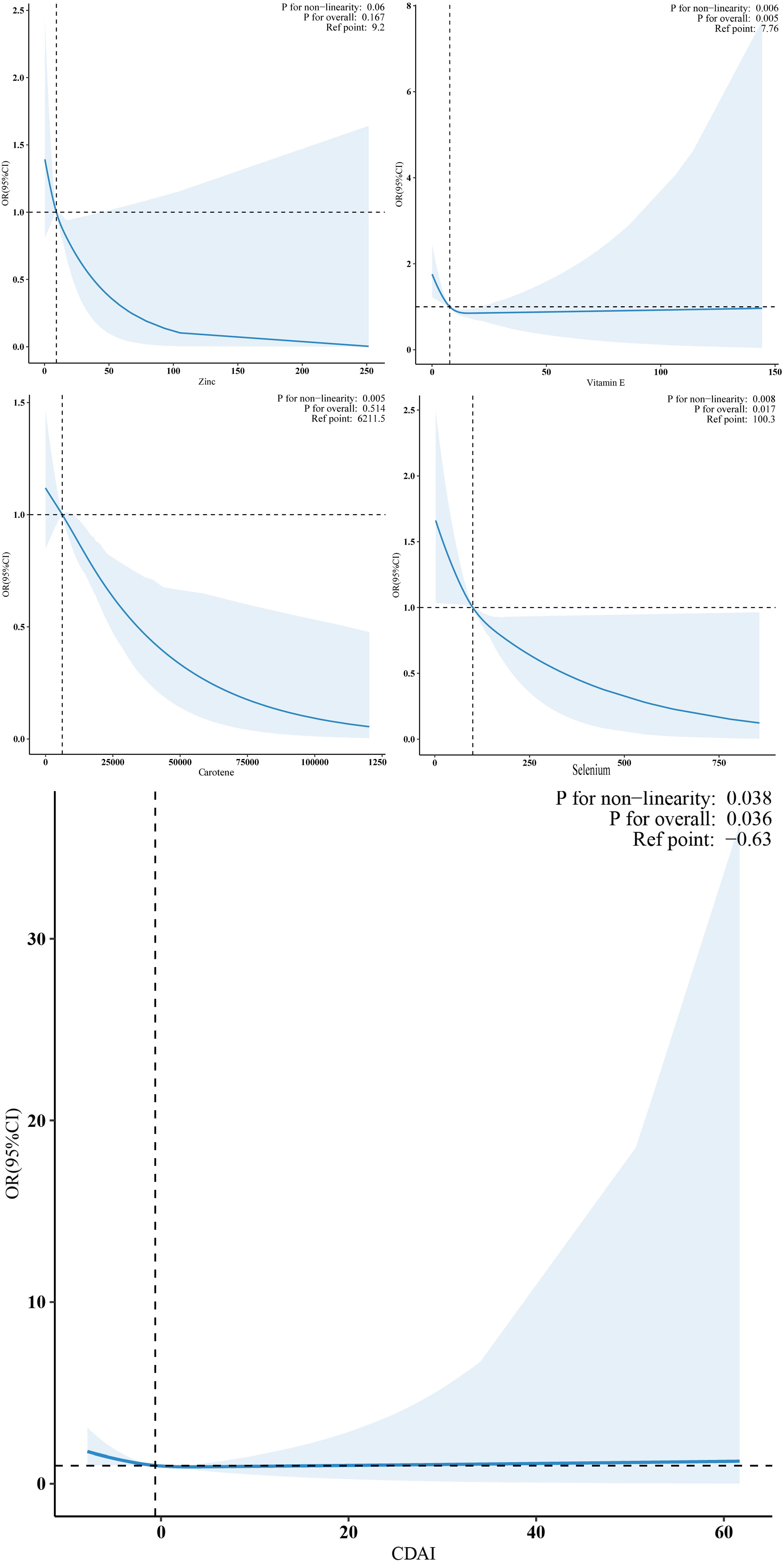
Figure 2. Restricted cubic spline curve (RCS) plot of the relationship between CDAI, vitamin E, carotene, selenium, and RA incidence.
3.3 Subgroup analysis of CDAI and RA
Subgroup analysis revealed that CDAI was negatively correlated with RA in males, individuals of “Other Race - Including Multi-Racial” ethnicity, smokers, non-drinkers, individuals with heavy activity status, those with hypertension, individuals aged >60, and those with BMI >25 (P < 0.05) (Figure 3).
3.4 Causal mediation analysis
We performed causal mediation analysis to further investigate the potential mediating role of BMI in the relationship between CDAI and RA. The mediation model and its paths are shown in Figure 4, where CDAI is the independent variable, BMI is the mediator, and RA is the dependent variable. The results showed that CDAI indirectly influenced the occurrence of RA through BMI, with an indirect effect of -0.0002 (95% CI: -0.0003, -0.0001, P < 0.001). This indicates that BMI partially mediated the relationship between CDAI and RA, accounting for 10.88% of the effect (Table 3).
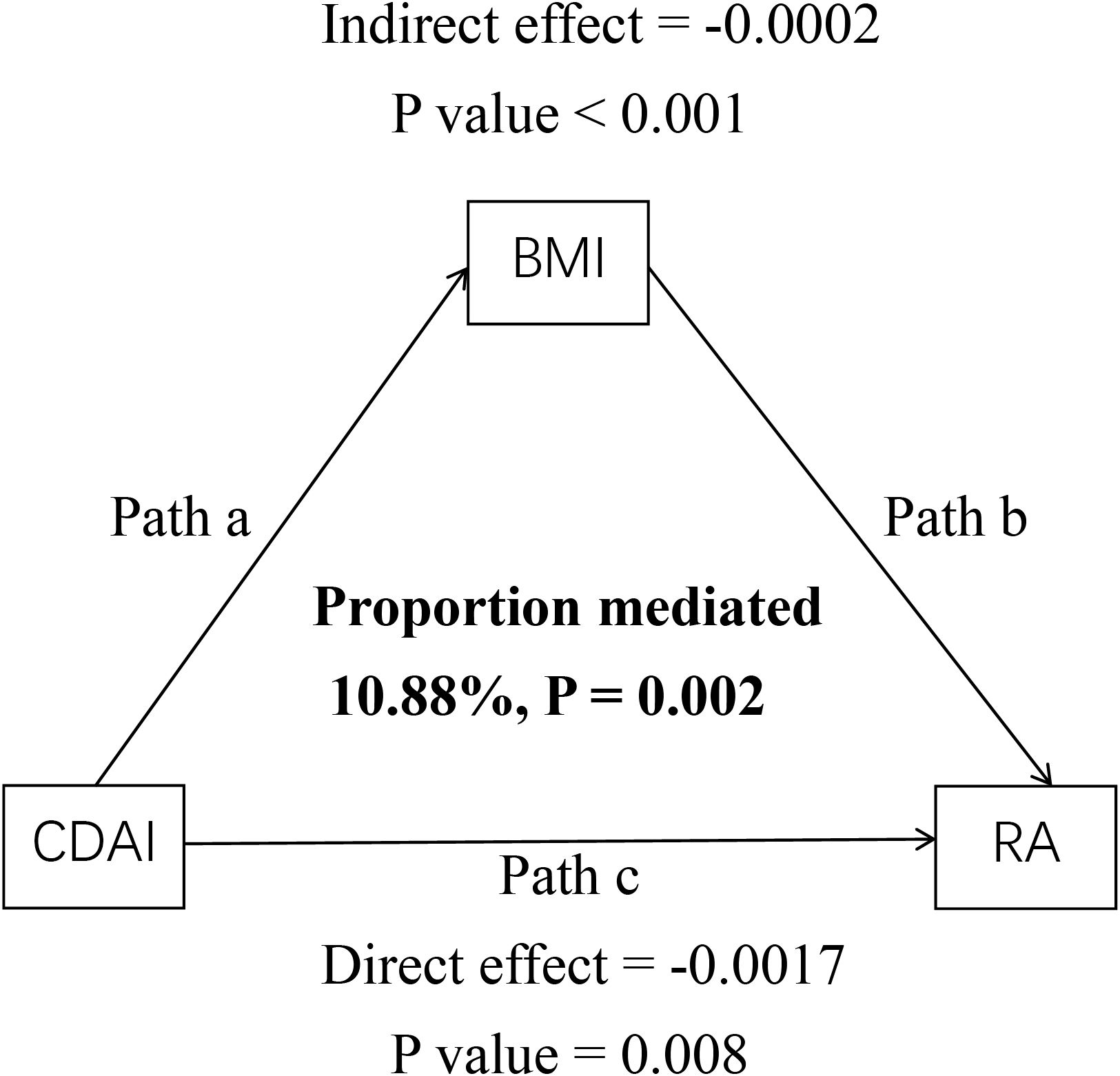
Figure 4. Mediated analysis model path diagram. Notes: CDAI was defined as the independent variable; RA as the dependent variable; and BMI as the mediating variable. Path a represents the regression coefficient of the association between CDAI and BMI. Path b represents the regression coefficient of the association between BMI and RA. Path c represents the direct effect of CDAI on RA.
4 Discussion
4.1 Negative correlation between CDAI and RA
In this study, we found a significant negative correlation between the Composite Dietary Antioxidant Index (CDAI) and the risk of rheumatoid arthritis (RA), revealing the important role of dietary antioxidants in the pathophysiology of RA. Specifically, higher CDAI (i.e., higher antioxidant intake) was associated with a lower risk of RA, particularly at the highest quartile level, where the relative risk of RA was significantly reduced. This negative correlation reflects the potential protective effects of dietary antioxidants against RA, and the following mechanisms may explain this association:
4.1.1 Oxidative stress and the pathogenesis of RA
Oxidative stress is considered one of the core mechanisms underlying RA development (21, 22). Altered antioxidant system and elevated serum and synovial fluid lipid peroxidation levels in patients with RA (23).The levels of oxidative stress in RA patients are significantly elevated, primarily due to the excessive production of reactive oxygen species (ROS) and reactive nitrogen species (RNS) (24, 25). These free radicals attack the synovial membrane, cartilage, and bone tissue, inducing inflammatory responses and exacerbating joint damage (25). In addition, ROS are able to activate or deactivate different types of receptors, proteins and signaling molecules. This consequently leads to cellular dysfunction, which in turn leads to the development of the pathological condition of rheumatoid arthritis (23). Oxidative stress also activates pro-inflammatory signaling pathways, such as NF-κB and JNK, further increasing the release of pro-inflammatory cytokines (e.g., TNF-α, IL-6, IL-1β), thereby amplifying the inflammatory response (26).
Dietary antioxidants (such as vitamin E, carotenoids, and selenium) can reduce oxidative stress-induced damage to joint tissues by scavenging free radicals and inhibiting the activation of pro-inflammatory signaling pathways (27–29). This explains why higher CDAI levels are associated with a significantly lower risk of RA.
4.1.2 Protective role of vitamin E in RA
Vitamin E, a major component of CDAI, is a potent lipid-soluble antioxidant that effectively scavenges ROS and lipid peroxides, protecting cell membranes and tissues from oxidative damage (14, 30). Kou H et al (31) showed that regular use of vitamin E supplements can help RA patients reduce joint discomfort, edema and stiffness and improve their overall quality of life. Recent results from a large cross-sectional study of 2906 participants suggest a beneficial relationship between increased dietary vitamin E intake and reduced risk of all-cause mortality in patients with RA (32). In addition, vitamin E exerts anti-inflammatory effects through several mechanisms:
Inhibition of NF-κB signaling: NF-κB is a key pro-inflammatory transcription factor involved in regulating the expression of various pro-inflammatory cytokines (33). In RA patients, the activation of the NF-κB pathway is closely related to joint inflammation (34). Vitamin E can reduce the release of pro-inflammatory cytokines (such as IL-1β, TNF-α) by inhibiting NF-κB activity (35), thereby alleviating joint inflammation.
Immune Response Modulation: Vitamin E enhances the function of T and B cells, promotes the secretion of anti-inflammatory cytokines (e.g., IL-10), and inhibits the expression of Th17 cells and pro-inflammatory cytokines (36, 37). This immunomodulatory effect may help mitigate the immune-mediated inflammatory response in RA.
4.1.3 Anti-inflammatory mechanism of carotenoids
Carotenoids are a class of plant flavonoid compounds with strong antioxidant properties (38). Carotenoids not only directly scavenge ROS but also exert immune-regulatory effects through their metabolites (e.g., retinol). The specific protective mechanisms of carotenoids in RA include:
Scavenging Free Radicals: Carotenoids, as effective free radical scavengers, can reduce oxidative stress levels in RA patients, protecting synovial cells and cartilage tissue from oxidative damage (39, 40).
Regulation of Immune Response: Carotenoids can inhibit the expression of pro-inflammatory cytokines (such as IL-6, TNF-α) (41) and promote the release of anti-inflammatory cytokines (such as IL-10) (42), thereby exerting anti-inflammatory and immune-modulatory effects in RA patients. Additionally, carotenoids can regulate macrophage function and reduce the spread of inflammatory responses (15).
4.1.4 Anti-inflammatory and immune-regulatory effects of selenium
Selenium, a key trace element in CDAI, exerts its antioxidant effects primarily through its role as a cofactor in glutathione peroxidase (GPx) and selenoprotein P (16). The specific protective mechanisms of selenium in RA include:
Enhancing Antioxidant Defense: Selenium, as a core component of GPx, promotes the breakdown of hydrogen peroxide and organic peroxides, reducing oxidative stress-induced damage to synovial cells and cartilage (43, 44). Selenium’s antioxidant role is particularly important for RA patients, as they often have elevated lipid peroxide levels.
Inhibition of Inflammatory Cytokine Expression: Selenium can inhibit the expression of pro-inflammatory cytokines by affecting signaling pathways such as NF-κB and Nrf2, thereby reducing the inflammatory response in synovial cells and macrophages (45).
Immune Function Modulation: Selenium regulates T and B cell functions, promotes the secretion of anti-inflammatory cytokines, and inhibits the proliferation of Th1 and Th17 cells (46), which in turn suppresses the immune-inflammatory response associated with RA.
4.1.5 Role of CDAI in overall dietary patterns
CDAI comprehensively assesses the intake of various antioxidants in the diet, thus reflecting not only individual nutrient intake but also the overall dietary pattern. A high CDAI score is usually associated with high intake of fruits, vegetables, nuts, and whole grains, all rich in antioxidants and anti-inflammatory compounds that exert a combined anti-inflammatory and immune-modulatory effect.
Mediterranean Diet Pattern: The high CDAI score resembles the Mediterranean diet, which is rich in olive oil, fish, fruits, and vegetables. Numerous studies have shown that the Mediterranean diet can reduce the risk of RA and improve symptoms in RA patients (47).
Role of Dietary Fiber: High CDAI scores are often associated with higher dietary fiber intake. Dietary fiber can reduce RA risk by altering the gut microbiota and increasing the production of anti-inflammatory short-chain fatty acids (e.g., butyrate) (48), thereby exerting an anti-inflammatory effect.
In conclusion, the negative correlation between CDAI and RA observed in this study may be attributed to the multifaceted protective mechanisms of dietary antioxidants, including scavenging free radicals, inhibiting pro-inflammatory signaling pathways, and modulating immune function. These results provide important insights for developing dietary intervention strategies for RA prevention and highlight the potential of optimizing antioxidant intake to reduce RA risk.
4.2 Mediating Role of BMI in the Relationship Between CDAI and RA
The differences between Models 3 and 4 in the results of this study suggest that the mediating role of BMI is not significant. In the mediation analysis, we found that BMI mediated approximately 10.88% of the relationship between CDAI and the risk of RA. This suggests that while BMI plays a role, the majority of the effect remains direct. Although dietary antioxidants (such as vitamin E, carotenoids, and selenium) play a significant role in reducing oxidative stress and inflammation, obesity may alter the metabolism and bioavailability of these antioxidants, thereby weakening their protective effects. This phenomenon can be explained by the following mechanisms:
Distribution and Storage of Antioxidants: Lipid-soluble antioxidants (e.g., vitamin E) are typically stored in adipose tissue (49). Individuals with obesity have larger amounts of adipose tissue, which may lead to a greater accumulation of antioxidants in fat tissue, reducing their availability in the bloodstream and joint tissues. This redistribution could weaken the direct role of antioxidants in mitigating oxidative stress and inflammation.
Oxidative Stress Environment in Adipose Tissue: Adipose tissue in individuals with obesity is often in a state of high oxidative stress, requiring more antioxidants to neutralize ROS (50). This means that even if dietary antioxidants are consumed at higher levels, their actual antioxidant effect may be offset by the obesity-induced oxidative environment.
Dietary Fiber and Anti-inflammatory Effects: Higher CDAI levels are generally associated with increased dietary fiber intake, which can promote gut microbiome diversity and enhance the production of anti-inflammatory short-chain fatty acids (SCFAs) (49). However, individuals with obesity often have gut microbiota imbalances (51), which may impact the metabolism and anti-inflammatory effects of dietary fiber.
Impact of Metabolic Syndrome: Obesity is commonly associated with metabolic syndrome, including insulin resistance, dyslipidemia, and hypertension (52). These metabolic abnormalities exacerbate the risk of RA (53) and may reduce the protective effects of dietary antioxidants.
4.3 Possibility of reverse causality between BMI and RA
RA itself may influence BMI, particularly due to the chronic inflammation associated with RA, which leads to weight loss, muscle mass depletion, and altered metabolic processes. While we acknowledge the possibility of reverse causality between BMI and RA, we believe BMI still plays a relevant mediating role in this study for the following key reasons.
Obesity and RA risk: Epidemiological studies consistently show that obesity is an important risk factor for the development of RA. Adipose tissue releases pro-inflammatory cytokines (such as IL-6 and TNF-α) (17), contributing to systemic inflammation that may exacerbate RA pathogenesis. This relationship suggests that BMI may increase the risk of RA, making it reasonable to consider BMI as a mediator in the relationship between CDAI and RA risk.
Chronic inflammation and obesity: The link between obesity and inflammation is well-documented in the literature, and it is increasingly recognized as a key factor in the development of various chronic diseases, including RA (54, 55). Given that dietary antioxidants have been shown to counteract inflammation, it is plausible to assume that higher antioxidant intake may mitigate obesity-related inflammation, thereby reducing RA risk.
Cross-sectional nature of the study: While we acknowledge the possibility of reverse causality, it is important to highlight that the cross-sectional design of this study provides a snapshot of the relationship between CDAI, BMI, and RA at a specific point in time. Longitudinal studies are necessary to fully explore and clarify the directionality of these relationships.
4.4 Clinical and public health implications
This finding provides new insights for RA prevention and management strategies. Based on the results of this study, increasing the intake of dietary antioxidants, particularly vitamin E, carotenoids, and selenium, may serve as an effective strategy for RA prevention. However, considering the mediating role of BMI, personalized dietary interventions should take participants’ weight status into account. For overweight and obese individuals, merely increasing antioxidant intake may not be sufficient to achieve the desired effects. In these populations, combining weight management strategies with increased physical activity and other comprehensive interventions may be more effective.
4.5 Limitations and future directions
Although this study reveals the negative correlation between CDAI and RA and the mediating role of BMI, as a cross-sectional study, the study can only establish an association between CDAI and RA and cannot infer causality. Additionally, the dietary data were obtained through 24-hour dietary recalls, which may be subject to recall bias and reporting errors. Furthermore, BMI, as a measure of obesity, does not differentiate between muscle mass and fat mass, limiting its explanatory power. In addition, the results of the present study showed that the statistical significance of CDAI in RA (p = 0.033) was relatively weak but equally statistically significant. Future studies should adopt longitudinal studies or randomized controlled trials to confirm the causal relationship between CDAI and RA risk. Moreover, further research is needed to explore the specific mechanisms of different antioxidants in RA prevention and treatment, and to evaluate the combined effects of weight management and dietary interventions.
5 Conclusion
This study demonstrates a significant negative correlation between the Composite Dietary Antioxidant Index (CDAI) and the risk of rheumatoid arthritis (RA) in American adults, with higher CDAI scores being associated with a reduced risk of RA. The findings highlight the potential protective role of dietary antioxidants, such as vitamin E, carotenoids, and selenium, in mitigating the inflammatory and oxidative stress components of RA. Additionally, BMI was found to partially mediate the relationship between CDAI and RA, suggesting that obesity may influence the effectiveness of dietary antioxidants in RA prevention. These results provide valuable insights into the potential of dietary interventions to reduce RA risk, particularly in high-risk populations such as those with obesity. Personalized dietary strategies that optimize antioxidant intake while considering weight management could offer a promising approach to RA prevention and management. Future longitudinal studies are necessary to confirm these findings and further elucidate the underlying mechanisms of dietary antioxidants in RA pathogenesis and treatment.
Data availability statement
The datasets presented in this study can be found in online repositories. The names of the repository/repositories and accession number(s) can be found below: All data are available in the NHANES database (www.cdc.gov/nchs/nhanes).
Ethics statement
The studies involving humans were approved by National Center for Health Statistics. The studies were conducted in accordance with the local legislation and institutional requirements. The participants provided their written informed consent to participate in this study.
Author contributions
TG: Data curation, Methodology, Software, Supervision, Writing – original draft, Writing – review & editing. ZC: Data curation, Methodology, Writing – review & editing. TL: Data curation, Writing – review & editing. JT: Data curation, Writing – review & editing. XL: Data curation, Writing – review & editing. HH: Data curation, Writing – review & editing. SW: Data curation, Writing – review & editing. CW: Data curation, Writing – original draft, Writing – review & editing.
Funding
The author(s) declare that no financial support was received for the research and/or publication of this article.
Conflict of interest
The authors declare that the research was conducted in the absence of any commercial or financial relationships that could be construed as a potential conflict of interest.
Generative AI statement
The author(s) declare that no Generative AI was used in the creation of this manuscript.
Publisher’s note
All claims expressed in this article are solely those of the authors and do not necessarily represent those of their affiliated organizations, or those of the publisher, the editors and the reviewers. Any product that may be evaluated in this article, or claim that may be made by its manufacturer, is not guaranteed or endorsed by the publisher.
References
1. Harre U, Schett G. Cellular and molecular pathways of structural damage in rheumatoid arthritis. Semin Immunopathol. (2017) 39:355–63. doi: 10.1007/s00281-017-0634-0
2. Almutairi K, Nossent J, Preen D, Keen H, Inderjeeth C. SAT0576 THE PREVALENCE OF RHEUMATOID ARTHRITIS: A SYSTEMATIC REVIEW OF POPULATION-BASED STUDIES. Ann Rheum Dis. (2020) 79:1246. doi: 10.1136/annrheumdis-2020-eular.696
3. Shi G, Liao X, Lin Z, Liu W, Luo X, Zhan H, et al. Estimation of the global prevalence, incidence, years lived with disability of rheumatoid arthritis in 2019 and forecasted incidence in 2040: results from the Global Burden of Disease Study 2019. Clin Rheumatol. (2023) 42:2297–309. doi: 10.1007/s10067-023-06628-2
4. Mititelu RR, Pădureanu R, Băcănoiu M, Pădureanu V, Docea AO, Calina D, et al. Inflammatory and oxidative stress markers—Mirror tools in rheumatoid arthritis. Biomedicines. (2020) 8:125. doi: 10.3390/biomedicines8050125
5. Shahin M, Eldeeb A, Elbanna H, Aboelhawa M. Quality of life assessment and its correlation with disease activity in rheumatoid arthritis patients. Int J Health Sci. (2022) 6:3090–106. doi: 10.53730/ijhs.v6nS9.13205
6. Kerstens F, Spijkers K, Wolthuis D, Boers M, van Herwaarden N, Ten CD. Switching from prednisolone to dexamethasone in difficult-to-treat rheumatoid arthritis. Rheumatology. (2024) 63:e15–6. doi: 10.1093/rheumatology/kead334
7. Al-Nemrawi N, Wahsheh Y, Alzoubi KH. Transdermal delivery of methotrexate loaded in chitosan nanoparticles to treat rheumatoid arthritis. Curr Drug Deliv. (2024) 21:451–60. doi: 10.2174/1567201820666230428124346
8. Hulander E, Bärebring L, Turesson WA, Gjertsson I, Calder PC, Winkvist A, et al. Proposed anti-inflammatory diet reduces inflammation in compliant, weight-stable patients with rheumatoid arthritis in a randomized controlled crossover trial. J Nutr. (2021) 151:3856–64. doi: 10.1093/jn/nxab313
9. Hulander E, Bärebring L, Turesson WA, Gjertsson I, Calder PC, Winkvist A, et al. Diet intervention improves cardiovascular profile in patients with rheumatoid arthritis: results from the randomized controlled cross-over trial ADIRA. Nutr J. (2021) 20:9. doi: 10.1186/s12937-021-00663-y
10. Chen X, Lu H, Chen Y, Sang H, Tang Y, Zhao Y. Composite dietary antioxidant index was negatively associated with the prevalence of diabetes independent of cardiovascular diseases. Diabetol Metab Syndr. (2023) 15:183. doi: 10.1186/s13098-023-01150-6
11. Zheng M, Li C, Fu J, Bai L, Dong J. Association between composite dietary antioxidant index and fatty liver index among US adults. Front Nutr. (2024) 11:1466807. doi: 10.3389/fnut.2024.1466807
12. Wu M, Si J, Liu Y, Kang L, Xu B. Association between composite dietary antioxidant index and hypertension: insights from NHANES. Clin Exp Hypertens. (2023) 45:2233712. doi: 10.1080/10641963.2023.2233712
13. Cerhan JR, Saag KG, Merlino LA, Mikuls TR, Criswell LA. Antioxidant micronutrients and risk of rheumatoid arthritis in a cohort of older women. Am J Epidemiol. (2003) 157:345–54. doi: 10.1093/aje/kwf205
14. Kilicarslan You D, Fuwad A, Lee KH, Kim HK, Kang L, Kim SM, et al. Evaluation of the protective role of vitamin E against ROS-driven lipid oxidation in model cell membranes. Antioxidants-Basel. (2024) 13(9):1135. doi: 10.3390/antiox13091135
15. Katsuura S, Imamura T, Bando N, Yamanishi R. beta-Carotene and beta-cryptoxanthin but not lutein evoke redox and immune changes in RAW264 murine macrophages. Mol Nutr Food Res. (2009) 53:1396–405. doi: 10.1002/mnfr.200800566
16. Stolwijk JM, Falls-Hubert KC, Searby CC, Wagner BA, Buettner GR. Simultaneous detection of the enzyme activities of GPx1 and GPx4 guide optimization of selenium in cell biological experiments. Redox Biol. (2020) 32:101518. doi: 10.1016/j.redox.2020.101518
17. Wang T, He C, Yu X. Pro-inflammatory cytokines: new potential therapeutic targets for obesity-related bone disorders. Curr Drug Targets. (2017) 18:1664–75. doi: 10.2174/1389450118666170104153512
18. Wright ME, Mayne ST, Stolzenberg-Solomon RZ, Li Z, Pietinen P, Taylor PR, et al. Development of a comprehensive dietary antioxidant index and application to lung cancer risk in a cohort of male smokers. Am J Epidemiol. (2004) 160:68–76. doi: 10.1093/aje/kwh173
19. Willenbring ML, Massey SH, Gardner MB. Helping patients who drink too much: an evidence-based guide for primary care clinicians. Am Fam Physician. (2009) 80:44–50.
20. Whelton PK, Carey RM, Aronow WS, Casey DJ, Collins KJ, Dennison HC, et al. 2017 ACC/AHA/AAPA/ABC/ACPM/AGS/APhA/ASH/ASPC/NMA/PCNA guideline for the prevention, detection, evaluation, and management of high blood pressure in adults: A report of the American college of cardiology/American heart association task force on clinical practice guidelines. J Am Coll Cardiol. (2018) 71:e127–248. doi: 10.1016/j.jacc.2017.11.006
21. Wang Y, Zhao X, Wang J, Zhu X. Norisoboldine reduces arthritis severity by attenuating inflammation, oxidative stress, and extracellular matrix degradation in a rat model of rheumatoid arthritis. J Inflammation Res. (2024) 17:8839–52. doi: 10.2147/JIR.S476824
22. Giordo R, Posadino AM, Maccioccu P, Capobianco G, Zinellu A, Erre GL, et al. Sera from rheumatoid arthritis patients induce oxidative stress and pro-angiogenic and profibrotic phenotypes in human endothelial cells. J Clin Med. (2024) 13(19):5913. doi: 10.3390/jcm13195913
23. Phull A, Nasir B, Haq IU, Kim SJ. Oxidative stress, consequences and ROS mediated cellular signaling in rheumatoid arthritis. Chem-Biol Interact. (2018) 281:121–36. doi: 10.1016/j.cbi.2017.12.024
24. Zamudio-Cuevas Y, Martínez-Flores K, Martínez-Nava GA, Clavijo-Cornejo D, Fernández-Torres J, Sánchez-Sánchez R. Rheumatoid arthritis and oxidative stress. Cell Mol Biol. (2022) 68:174–84. doi: 10.14715/cmb/2022.68.6.28
25. Khojah HM, Ahmed S, Abdel-Rahman MS, Hamza A. Reactive oxygen and nitrogen species in patients with rheumatoid arthritis as potential biomarkers for disease activity and the role of antioxidants. Free Radical Bio Med. (2016) 97:285–91. doi: 10.1016/j.freeradbiomed.2016.06.020
26. Chen X, Li X, Zhang W, He J, Xu B, Lei B, et al. Activation of AMPK inhibits inflammatory response during hypoxia and reoxygenation through modulating JNK-mediated NF-&x3ba;B pathway. Metab - Clin Exp. (2018) 83:256–70. doi: 10.1016/j.metabol.2018.03.004
27. Yang J, Song X, Feng Y, Liu N, Fu Z, Wu J, et al. Natural ingredients-derived antioxidants attenuate H2O2-induced oxidative stress and have chondroprotective effects on human osteoarthritic chondrocytes via Keap1/Nrf2 pathway. Free Radical Bio Med. (2020) 152:854–64. doi: 10.1016/j.freeradbiomed.2020.01.185
28. Tang Y, Xu X, Zhang S, Kong W, Zhang W, Zhu T. Genetic liability for diet-derived circulating antioxidants, oxidative stress, and risk of osteoarthritis: a Mendelian randomization study. Front Nutr. (2023) 10:1233086. doi: 10.3389/fnut.2023.1233086
29. Chaudhary P, Janmeda P, Docea AO, Yeskaliyeva B, Abdull Razis AF, Modu B, et al. Oxidative stress, free radicals and antioxidants: potential crosstalk in the pathophysiology of human diseases. Front Chem. (2023) 11:1158198. doi: 10.3389/fchem.2023.1158198
30. Niki E. Role of vitamin E as a lipid-soluble peroxyl radical scavenger: in vitro and in vivo evidence. Free Radical Bio Med. (2014) 66:3–12. doi: 10.1016/j.freeradbiomed.2013.03.022
31. Kou H, Qing Z, Guo H, Zhang R, Ma J. Effect of vitamin E supplementation in rheumatoid arthritis: a systematic review and meta-analysis. Eur J Clin Nutr. (2023) 77:166–72. doi: 10.1038/s41430-022-01148-9
32. Yin Y, Dong Y, Cao Y, Dong G. Association of vitamin E intake with all-cause mortality among individuals with rheumatoid arthritis: A cohort study from the NHANES 1999-2018. J Am Nutr Assoc. (2025) 44:89–95. doi: 10.1080/27697061.2024.2401055
33. Anilkumar S, Wright-Jin E. NF-κB as an inducible regulator of inflammation in the central nervous system. Cells-Basel. (2024) 13(6):485. doi: 10.3390/cells13060485
34. Liao H, Zheng J, Lu J, Shen H. NF-κB signaling pathway in rheumatoid arthritis: mechanisms and therapeutic potential. Mol Neurobiol. (2024). doi: 10.1007/s12035-024-04634-2
35. üremi _ N, üremi _ MM, Gül M, özsoy EN, Türköz Y. Protective effects of vitamin E against acrylamide-induced hepatotoxicity and nephrotoxicity from fetal development to adulthood: Insights into Akt/NF-κB and Bcl-xL/Bax signaling pathways. Toxicology. (2024) 502:153729. doi: 10.1016/j.tox.2024.153729
36. Lee GY, Han SN. The role of vitamin E in immunity. Nutrients. (2018) 10(11):1614. doi: 10.3390/nu10111614
37. Hafkamp FMJ, Taanman-Kueter EWM, van Capel TMM, Kormelink TG, de Jong EC. Vitamin D3 priming of dendritic cells shifts human neutrophil-dependent th17 cell development to regulatory T cells. Front Immunol. (2022) 13:872665. doi: 10.3389/fimmu.2022.872665
38. Anand R, Mohan L, Bharadvaja N. Disease prevention and treatment using β-carotene: the ultimate provitamin A. Rev Bras Farmacognosia. (2022) 32:491–501. doi: 10.1007/s43450-022-00262-w
39. Zhou X, Mi J, Liu Z. Causal association of diet-derived circulating antioxidants with the risk of rheumatoid arthritis: A Mendelian randomization study. Semin Arthritis Rheu. (2022) 56:152079. doi: 10.1016/j.semarthrit.2022.152079
40. Paiva SA, Russell RM. Beta-carotene and other carotenoids as antioxidants. J Am Coll Nutr. (1999) 18:426–33. doi: 10.1080/07315724.1999.10718880
41. Bai S, Lee S, Na H, Ha K, Han J, Lee H, et al. beta-Carotene inhibits inflammatory gene expression in lipopolysaccharide-stimulated macrophages by suppressing redox-based NF-kappaB activation. Exp Mol Med. (2005) 37:323–34. doi: 10.1038/emm.2005.42
42. Novoselova EG, Lunin SM, Novoselova TV, Khrenov MO, Glushkova OV, Avkhacheva NV, et al. Naturally occurring antioxidant nutrients reduce inflammatory response in mice. Eur J Pharmacol. (2009) 615:234–40. doi: 10.1016/j.ejphar.2009.05.004
43. Kiełczykowska M, Kocot J, Paździor M, Musik I. Selenium - a fascinating antioxidant of protective properties. Adv Clin Exp Med. (2018) 27:245–55. doi: 10.17219/acem/67222
44. Deng H, Liu H, Yang Z, Bao M, Lin X, Han J, et al. Progress of selenium deficiency in the pathogenesis of arthropathies and selenium supplement for their treatment. Biol Trace Elem Res. (2022) 200:4238–49. doi: 10.1007/s12011-021-03022-4
45. Cheng H, Yen C, Huang L, Hu Y, Huang T, Hsieh B, et al. Selenium lessens osteoarthritis by protecting articular chondrocytes from oxidative damage through nrf2 and NF-κB pathways. Int J Mol Sci. (2024) 25(5):2511. doi: 10.3390/ijms25052511
46. Niu R, Yang Q, Dong Y, Hou Y, Liu G. Selenium metabolism and regulation of immune cells in immune-associated diseases. J Cell Physiol. (2022) 237:3449–64. doi: 10.1002/jcp.v237.9
47. Forsyth C, Kouvari M D, Cunha NM, Georgousopoulou EN, Panagiotakos DB, Mellor DD, et al. The effects of the Mediterranean diet on rheumatoid arthritis prevention and treatment: a systematic review of human prospective studies. Rheumatol Int. (2018) 38:737–47. doi: 10.1007/s00296-017-3912-1
48. Bach Knudsen KE, Lærke HN, Hedemann MS, Nielsen TS, Ingerslev AK, Gundelund Nielsen DS, et al. Impact of diet-modulated butyrate production on intestinal barrier function and inflammation. Nutrients. (2018) 10(10):1499. doi: 10.3390/nu10101499
49. Landrier J. Vitamine E et physiologie du tissu adipeux. Ocl Oils Fat Crop Li. (2011) 18:83–7. doi: 10.1051/ocl.2011.0370
50. Sinha JK, Ghosh S, Raghunath M. Concomitant high oxidative stress and poor antioxidant enzyme activity with DNA damage may underlie obesity and reduced longevity in WNIN/Ob obese rats. J Neurol Sci. (2021) 429. doi: 10.1016/j.jns.2021.118615
51. Crovesy L, Masterson D, Rosado EL. Profile of the gut microbiota of adults with obesity: a systematic review. Eur J Clin Nutr. (2020) 74:1251–62. doi: 10.1038/s41430-020-0607-6
52. Ntougou Assoumou H, Pichot V, Barthelemy J, Celle S, Garcin A, Thomas T, et al. Obesity related to metabolic syndrome: comparison of obesity indicators in an older french population. Diabetol Metab Syndr. (2023) 15:98. doi: 10.1186/s13098-023-01078-x
53. Bagheri-Hosseinabadi Z, Moadab F, Abbasifard M. Prevalence and contributing factors of metabolic syndrome in rheumatoid arthritis patients. BMC Endocr Disord. (2024) 24:140. doi: 10.1186/s12902-024-01675-5
54. George MD, Baker JF. The obesity epidemic and consequences for rheumatoid arthritis care. Curr Rheumatol Rep. (2016) 18:6. doi: 10.1007/s11926-015-0550-z
Keywords: rheumatoid arthritis, composite dietary antioxidant index, body mass index, mediating role, NHANES
Citation: Gao T, Chen Z-Y, Li T, Tang J-D, Lin X, Hu H-G, Wan S-Y and Wu C (2025) The relationship between the composite dietary antioxidant index and rheumatoid arthritis risk in American adults: the mediating role of BMI. Front. Immunol. 16:1560570. doi: 10.3389/fimmu.2025.1560570
Received: 14 January 2025; Accepted: 17 March 2025;
Published: 09 April 2025.
Edited by:
Lucía Silva-Fernández, Complejo Hospitalario de Pontevedra, SpainReviewed by:
Sheng-Guang Li, Peking University, ChinaM. Thenmozhi, Technology & Advanced Studies (VISTAS), India
Copyright © 2025 Gao, Chen, Li, Tang, Lin, Hu, Wan and Wu. This is an open-access article distributed under the terms of the Creative Commons Attribution License (CC BY). The use, distribution or reproduction in other forums is permitted, provided the original author(s) and the copyright owner(s) are credited and that the original publication in this journal is cited, in accordance with accepted academic practice. No use, distribution or reproduction is permitted which does not comply with these terms.
*Correspondence: Tao Gao, Mzc0NjQ4MDI3QHFxLmNvbQ==; Chao Wu, ZmxpZ2h0aW5lc3NAMTYzLmNvbQ==
 Tao Gao
Tao Gao Zhi-Yu Chen2
Zhi-Yu Chen2